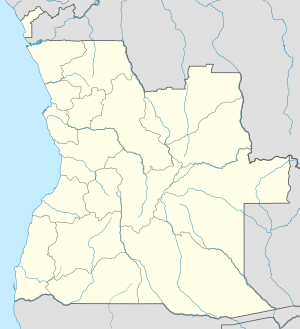Huambo
|
Huambo Nova Lisboa (New Lisbon) colonial name |
|
|---|---|
| Municipality and town | |

Governor's Palace, Cidade Alta, Huambo, Angola
|
|
| Location in Angola | |
| Coordinates: 12°46′S 15°44′E / 12.767°S 15.733°E | |
| Country |
|
| Province | Huambo |
| Founded | August 8, 1912 |
| Area | |
| • Municipality and town | 2,609 km2 (1,007 sq mi) |
| Elevation | 1,721 m (5,646 ft) |
| Population (2014 Census) | |
| • Municipality and town | 665,574 |
| • Density | 245.5/km2 (636/sq mi) |
| • Metro | 1,896,147 |
| Time zone | WAT (UTC+1) |
| Climate | Cwb |
Huambo, formerly Nova Lisboa (English: New Lisbon), (1928-1975), is the capital of the province of Huambo in Angola. The city is located about 220 km E from Benguela and 600 km SE from Luanda. The city is the second largest in Angola, after the capital city, Luanda. Huambo is a main hub on the Caminho de Ferro de Benguela (CFB) (the Benguela Railway), which runs from the port of Lobito to the Democratic Republic of the Congo's southernmost province, Katanga. Huambo is served by the Albano Machado Airport (formerly Nova Lisboa Airport).
Situated in the Angolan central highlands, Huambo is located near the headwaters of the Kunene River.
Huambo receives its name from Wambu, one of the 14 old Ovimbundu kingdoms of the central Angolan plateau. The Ovimbundu, an old tribe originally arrived from Eastern Africa, had founded their central kingdom of Bailundu as early as the 15th century. Wambu was one of the smaller kingdoms and was hierarchically under the king of Bailundu, though it enjoyed, as the other kingdoms, a considerable degree of independence.
Whereas Bailundo is mentioned in some 18th and 19th-century chronicles in connection to a trading route linking it with Viye (Bie), small Wambu was only really known with the advent of the construction of the Benguela Railway by the Portuguese. Though the kings of Bailundu and Wambu (particularly Ekuikui II and Katiavala I) opposed the penetration of the railway by ambushing workers and settlers, they were eventually subdued by the Portuguese Army and Huambo was officially founded on 8 August 1912 by the Governor-General of Angola Norton de Matos.
The origin of Huambo and the economic importance it reached under Portuguese administration is very closely linked to the construction of the Caminho de Ferro de Benguela (Benguela Railway), which had started in the coastal town of Lobito in 1902. This railroad had been devised by the British entrepreneur Sir Robert Williams as the easiest and cheapest way to link the rich copper mines of Katanga, in Belgian Congo, with a point on the coast from which the mineral could be exported. The Lobito bay was admittedly the best natural seaport in the whole continent.
...
Wikipedia

